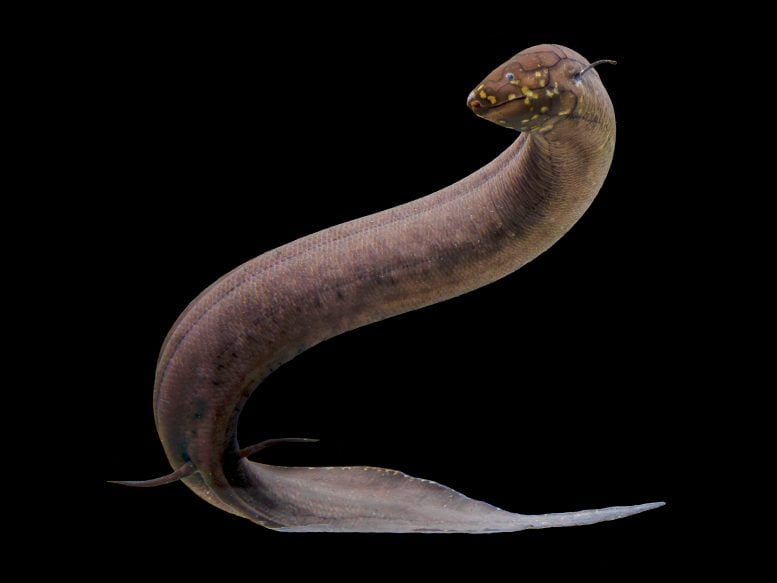Scientists Decode the World’s Largest Animal Genome


An international research team directed by Axel Meyer, an evolutionary biologist from Konstanz, and Manfred Schartl, a biochemist from Würzburg, has successfully sequenced the lungfish genome, which is thirty times larger than the human genome.
Join us as we travel back in time! We have arrived in the Devonian period, some 420 to 360 million years ago. In a shallow area near the water’s edge, something happened that would forever change life on our planet: a fish from the class of lobe-finned fishes uses its pair of powerful pectoral fins to pull itself out of the shallow water onto land, moving its body across the sludgy surface at the shoreline. The fish is in no hurry to return to the water. It can easily breathe air, because this fish already has lungs, like we land vertebrates still do today.
This scenario or one similar to it could have been the first time a vertebrate moved on land, one of the most important events in evolutionary history. Because all later land vertebrates, or tetrapods, can be traced back to a fish. This encompasses not only amphibians, reptiles and birds, but also mammals – humans included. Yet one mystery remains: Why were the fish of this lobe-finned lineage so well prepared to conquer land?
A Look at Its Living Relatives
To find the answer to this question after such a long time, the genetic material of the closest living relatives of our Devonian ancestor has now been analyzed, making it possible to draw conclusions about its appearance. Only three lineages of these closest relatives, the lungfish, are still alive today: one in Africa, one in South America, and one in Australia.
It seems that evolution has forgotten them, because these ancient “living fossils” still look very much like their ancestors. Since our genetic material, the DNA, is made up of nucleobases and the sequence of these nucleobases contains the actual genetic information, a comparative analysis of the lungfish genomes is only possible with knowledge of their complete sequences.

We already knew that the genomes of lungfish are huge, but how gigantic they really are and what can be learned from them was not clear until now. Accordingly, the sequencing of the lungfish genomes was very labor-intensive and complicated from both a technical and a bioinformatic perspective.
However, an international research team led by Konstanz biologist Axel Meyer and Würzburg biochemist Manfred Schartl has now succeeded in fully sequencing the genome of the South American lungfish and that of a member of the African lineage. The previously largest genome sequence of the Australian lungfish (Neoceratodus) had already been sequenced by the same team. The findings of their latest research were published in the journal Nature.
Very, Very Big, but Why?
The genetic material of the South American lungfish in particular breaks all records for size: “With over 90 gigabases (in other words, 90 billion bases), the DNA of the South American species is the largest of all animal genomes and more than twice as large as the genome of the previous record holder, the Australian lungfish. 18 of the 19 chromosomes of the South American lungfish are each individually larger than the entire human genome with its almost 3 billion bases,” says Meyer.
Autonomous transposons are responsible for the fact that the lungfish genome has ballooned to this enormous size over time. These are DNA sequences that “replicate” and then change their position in the genome, which in turn causes the genome to grow.
Although this occurs in other organisms as well, the research team’s analyses showed that the expansion rate of the genome of the South American lungfish is by far the fastest on record: Every 10 million years in the past, its genome has grown by the size of the entire human genome. “And it continues to grow,” reports Meyer. “We have found evidence that the transposons responsible are still active.” The researchers identified the mechanism for this gigantic genome growth: The extreme expansion is at least partially due to very low piRNA abundance. This type of RNA is part of a molecular mechanism that normally silences transposons.
Remarkably Stable Nonetheless
Because transposons replicate and jump around in the genome, thereby contributing to its growth, they can greatly alter and destabilize the genetic material of an organism. This is not always detrimental, and it can even be an important driver of evolution, as these “jumping genes” sometimes also cause evolutionary innovations by altering gene functions.
This makes it all the more surprising that the current study found no correlation between the enormous transposon surplus and genome instability – the genome of the lungfish is unexpectedly stable and the gene arrangement is surprisingly conservative. This fact enabled the research team to reconstruct the original architecture of the set of chromosomes (karyotype) of the ancestral tetrapod from the sequences of the lungfish species that are still alive today.
In addition, the comparison of the lungfish genomes enabled them to draw conclusions about the genetic basis of differences between the lineages still alive today. The Australian lungfish, for example, still has the limb-like fins that once enabled its relatives to move on land. In today’s other lungfish species from Africa and South America, these fins, which are similar in bone structure to our arms, evolved back into filamentous fins over the last 100 million years or so. “In our research, we also used experiments with CRISPR-Cas transgenic mice to show that this simplification of the fins is attributable to a change in what is known as the Shh-signalling pathway,” says Meyer.
During the embryonic development of mice, for example, the Shh-signalling pathway controls the number and development of the fingers, among other things. The research findings thus provide additional evidence of the evolutionary link between the ray fins of bony fish and the fingers of land vertebrates. As scientists now have the complete genome sequences of all current lungfish families at their disposal thanks to the new research, additional comparative genomic studies will provide further insights into the lobe-finned ancestors of land vertebrates in the future – and help solve the mystery of how vertebrates made their way onto land.
Reference: “The genomes of all lungfish inform on genome expansion and tetrapod evolution” by Manfred Schartl, Joost M. Woltering, Iker Irisarri, Kang Du, Susanne Kneitz, Martin Pippel, Thomas Brown, Paolo Franchini, Jing Li, Ming Li, Mateus Adolfi, Sylke Winkler, Josane de Freitas Sousa, Zhuoxin Chen, Sandra Jacinto, Evgeny Z. Kvon, Luis Rogério Correa de Oliveira, Erika Monteiro, Danielson Baia Amaral, Thorsten Burmester, Domitille Chalopin, Alexander Suh, Eugene Myers, Oleg Simakov, Igor Schneider and Axel Meyer, 14 August 2024, Nature.
DOI: 10.1038/s41586-024-07830-1
The study was funded by the German Research Foundation (DFG) and the Next Generation Sequencing Competence Network (NGS-CN).
Source link



